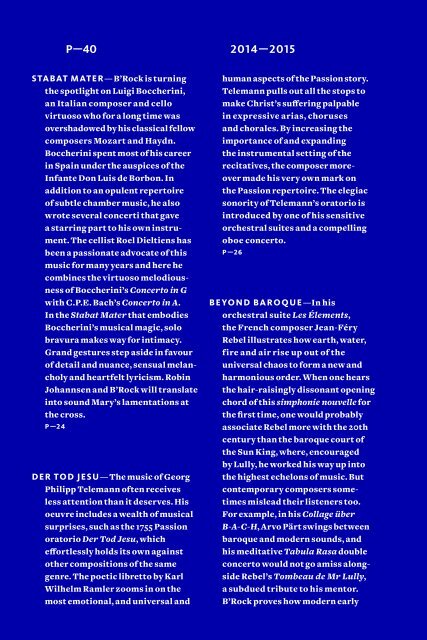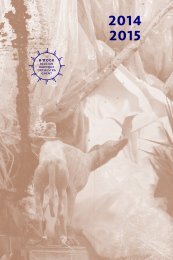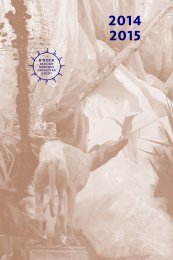You also want an ePaper? Increase the reach of your titles
YUMPU automatically turns print PDFs into web optimized ePapers that Google loves.
P—40<br />
2014—2015<br />
STABAT MATER— B’Rock is turning<br />
the spotlight on Luigi Boccherini,<br />
an Italian composer and cello<br />
virtuoso who for a long time was<br />
overshadowed by his classical fellow<br />
composers Mozart and Haydn.<br />
Boccherini spent most of his career<br />
in Spain under the auspices of the<br />
Infante Don Luis de Borbon. In<br />
addition to an opulent repertoire<br />
of subtle chamber music, he also<br />
wrote several concerti that gave<br />
a starring part to his own instrument.<br />
The cellist Roel Dieltiens has<br />
been a passionate advocate of this<br />
music for many years and here he<br />
combines the virtuoso melodiousness<br />
of Boccherini’s Concerto in G<br />
with C.P.E. Bach’s Concerto in A.<br />
In the Stabat Mater that embodies<br />
Boccherini’s musical magic, solo<br />
bravura makes way for intimacy.<br />
Grand gestures step aside in favour<br />
of detail and nuance, sensual melancholy<br />
and heartfelt lyricism. Robin<br />
Johannsen and B’Rock will translate<br />
into sound Mary’s lamentations at<br />
the cross.<br />
P—24<br />
DER TOD JESU— The music of Georg<br />
Philipp Telemann often receives<br />
less attention than it deserves. His<br />
oeuvre includes a wealth of musical<br />
surprises, such as the 1755 Passion<br />
oratorio Der Tod Jesu, which<br />
effortlessly holds its own against<br />
other compositions of the same<br />
genre. The poetic libretto by Karl<br />
Wilhelm Ramler zooms in on the<br />
most emotional, and universal and<br />
human aspects of the Passion story.<br />
Telemann pulls out all the stops to<br />
make Christ’s suffering palpable<br />
in expressive arias, choruses<br />
and chorales. By increasing the<br />
importance of and expanding<br />
the instrumental setting of the<br />
recitatives, the composer moreover<br />
made his very own mark on<br />
the Passion repertoire. The elegiac<br />
sonority of Telemann’s oratorio is<br />
introduced by one of his sensitive<br />
orchestral suites and a compelling<br />
oboe concerto.<br />
P—26<br />
BEYOND BAROQUE—In his<br />
orchestral suite Les Élements,<br />
the French composer Jean-Féry<br />
Rebel illustrates how earth, water,<br />
fire and air rise up out of the<br />
universal chaos to form a new and<br />
harmonious order. When one hears<br />
the hair-raisingly dissonant opening<br />
chord of this simphonie nouvelle for<br />
the first time, one would probably<br />
associate Rebel more with the 20th<br />
century than the baroque court of<br />
the Sun King, where, encouraged<br />
by Lully, he worked his way up into<br />
the highest echelons of music. But<br />
contemporary composers sometimes<br />
mislead their listeners too.<br />
For example, in his Collage über<br />
B-A-C-H, Arvo Pärt swings between<br />
baroque and modern sounds, and<br />
his meditative Tabula Rasa double<br />
concerto would not go amiss alongside<br />
Rebel’s Tombeau de Mr Lully,<br />
a subdued tribute to his mentor.<br />
B’Rock proves how modern early





